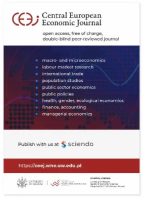Modelling cross-sectional tabular data using convolutional neural networks: Prediction of corporate bankruptcy in Poland
Modelling cross-sectional tabular data using convolutional neural networks: Prediction of corporate bankruptcy in Poland
Author(s): Aneta Dzik-Walczak, Maciej OdziemczykSubject(s): Economy, Financial Markets
Published by: Wydawnictwa Uniwersytetu Warszawskiego
Keywords: convolutional neural networks;machine learning;simulation;bankruptcy prediction;financial indicators
Summary/Abstract: The paper deals with the topic of modelling the probability of bankruptcy of Polish enterprises using convolutional neural networks. Convolutional networks take images as input, so it was thus necessary to apply the method of con-verting the observation vector to a matrix. Benchmarks for convolutional networks were logit models, random forests, XGBoost, and dense neural networks. Hyperparameters and model architecture were selected based on a random search and analysis of learning curves and experiments in folded, stratified cross-validation. In addition, the sensitivity of the results to data preprocessing was investigated. It was found that convolutional neural networks can be used to analyze cross-sectional tabular data, especially for the problem of modelling the probability of corporate bankruptcy. In order to achieve good results with models based on parameters updated by a gradient (neural networks and logit), it is necessary to use appropriate preprocessing techniques. Models based on decision trees have been shown to be insensitive to the data transformations used.
Journal: Central European Economic Journal
- Issue Year: 8/2021
- Issue No: 55
- Page Range: 352-377
- Page Count: 26
- Language: English

